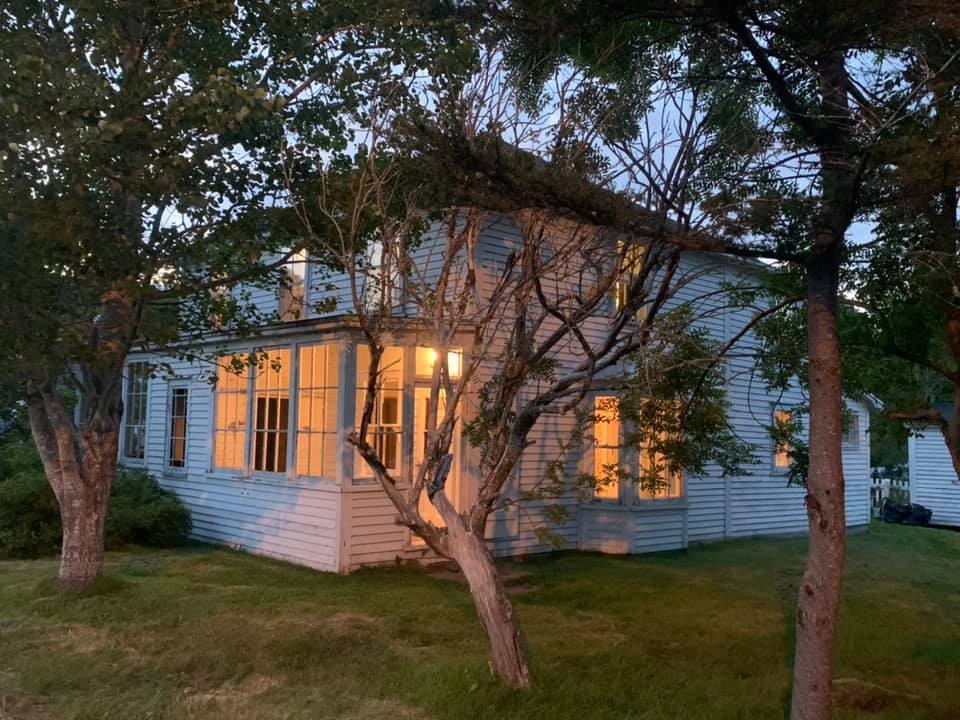
Many homebuyers dream of owning a piece of history. According to the Canadian Register of Historic Places, over 12,300 historic places are listed in Canada. Historic homes are often located in sought-after neighbourhoods, possess attractive design features, and qualify for tax credits. But these homes can be expensive to maintain and are often subject to strict preservation guidelines.
Talking Newfoundland Historic Homes with the Newfoundland & Labrador Historic Trust
To learn more about Newfoundland’s historic homes we sat down with Luke Quinton and Michael Philpott of the Newfoundland and Labrador Historic Trust to discuss what’s involved with owning a historic home and the challenges owners can face. The Newfoundland and Labrador Historic Trust is dedicated to the preservation of the province’s historic buildings and landscapes and their importance to communities.
In Newfoundland & Labrador, what makes an old home a historic home?
Historic Trust: Good Question! Usually, it’s some combination of the age of the home and the details — people in the 1800s and 1900s wanted their homes to express something about them, and the way craftspeople usually did that was through decoration and proportions. So that’s why you’ll see adornments like the brackets in the eaves, multiple trim lines around windows, and curved bay windows. Little details that make the home unique and beautiful. Of course, now we’re entering an era where mid-century homes (the 1940s-1960s) are considered historical, but they have completely different styles and proportions. Your home could be designated as historic by a city, a province, or even federally.
What’s involved in maintaining status?
Historic Trust: The city and federal governments have different requirements. Still, if you have a provincially registered home or building, there will be a list of details that the Heritage Foundation (Heritage NL) wants to be preserved. The broad idea is that the owner will maintain the building using building materials of the time, such as clapboard and wood windows and doors. That’s the most critical detail. Steel doors and vinyl windows cannot replicate the look of the original wood. In exchange, the province has funding available to help you keep the building in good condition. If you travel the province, you can tell which buildings have been designated by looking for a Heritage NL plaque. There are some beautiful buildings out there.
What can you do / not do to a historic home?
Historic Trust: Ideally, we hope heritage homeowners keep the home’s character as it was throughout history. So, keeping the clapboard is essential. So is the roof line (maybe you have a dormer, a mansard roof, or a steep gable). Wooden windows, like those made today on the Bonavista Peninsula, are beautiful and can be painted to match trim colours. But the fantastic thing about wood is that it can be repaired and maintained for decades, whereas other materials would be tossed out. So, it’s worth checking to see if they can be restored.
Depending on whether your home is registered with Heritage NL or, say, the City of St. John’s, there will be details on the exterior of the house that they’ll ask you to keep or even restore, and there are grants available to help you do that. It’s always worth reaching out to them to ask.
Of course, the interior is really up to you. Keep most of the woodwork, trim, brick, mantles, doors, and plaster details because they tell the house’s story and show the level of craft and design that was once available. You can’t really recreate those spaces again. But at the same time, there are modern improvements that will make the home more comfortable: adding insulation (as well as vapour barriers and a rain screen), up-to-date electrical work, adding interior or exterior storm windows, modern heating systems, all these improvements will help make sure your heritage home is basically as efficient as most modern buildings.
What challenges do owners of historic homes face?
Historic Trust: It depends on the history of maintenance and upgrades in the house! A 130-year-old has seen a lot of people and families over the decades. And the range of what’s under the hood is all over the map. Some older homes were built with lumber that would exceed the building code today, and they may have been fitted out with hardwoods and bricks imported from England. This is lovely stuff. At the same time, there was no building code at the time, so, for instance, my house in St. John’s is built with floor joists that are 24 inches on centre. And not with dimensional, stamped lumber, of course, so through the years, previous homeowners added a modern beam in the basement to stop the floors from moving down the hill (it’s a big hill). They fixed the main and second floors, but not the third, for some reason, so that’s our next project. At the same time, my grandmother’s family home in Bonavista Bay, which is older than my house by a decade, was built with quite modern-looking joists, and the floors are perfectly flat. It can be a bit frustrating! You ask yourself, “why!” a lot, haha.
But for the most part, if the foundation is sound, and the renovations through the years were sympathetic to the age and design, heritage homes can be straightforward to maintain. Make sure the chimney is watertight, and inspect your wood windows every year or two to ensure the paint and wood are still in good condition. Check clapboard and trim every few years, and when it’s time to repaint, seek out the companies that (at least on the Avalon) offer 10-year warranties on their paint jobs.
Any recent examples of a historic home being lost, either to a fire, or flood, or perhaps the existing owner cannot keep up status?
Historic Trust: This is a very contentious issue for the Historic Trust, of course! A building is much more likely to be maintained and survive if occupied. It’s just safer, there is someone there to spot leaks, and the building is being used, which is what most of us want to see, anyway. The most recent significant building to be lost to fire was the Ashbourne House in Twillingate. There was also the Belvedere Orphanage in St. John’s. That was a beautiful brick building, but again, it was not occupied. That’s often the kiss of death.
Every now and then, a registered building is de-listed, but usually, it’s because the owner wants to do something that is a stretch too far for it to keep its heritage status.
There’s a history in St. John’s of “demolition by neglect,” which is basically an underhanded way of demolishing a building when the community would like it saved. Heritage buildings add a lot to the province’s look, feel, and culture, and we’re willing to see modern buildings alongside them as long as the heritage building is kept up and used.
Insuring a Historic Property
If you own a historic property or are considering purchasing one, ensure your investment is a top priority. You could be out tens of thousands of dollars (or more) without proper coverage if your home sustains significant damage.
Not all insurance companies cover historic homes, and there are several factors that you should be aware of when choosing your coverage. Remember, too, that your premiums will be more than what you might pay to insure a newer home.
Just How Old is that Historic House?
The age and condition of a house are significant underwriting considerations since older homes use building materials that are more expensive or aren’t widely used today. For example, your home may have plaster walls, carved molding, solid-brass fixtures, or stained-glass windows. Older homes, especially those featuring Newfoundland architecture, also often don’t meet modern building code requirements. Some insurers may decline to cover a house with old wiring, that needs repair or is on a list of historic properties, citing the high cost and difficulty of replacing materials since historic landmarks must be renovated as initially built.
Keep in mind an old house isn’t necessarily a historic house. According to the Government of Canada, for a property to be considered a heritage property, it must have a significant impact on Canadian history or be an important illustration or example of Canadian human history. In addition, the property must be at least 40 years old or older. The Historic Sites and Monuments Board of Canada approves and decides on the potential heritage significance of a building.
Registered homes present their own insurance challenges, and it’s best to work with an insurance broker specializing in historic properties. The process begins with a detailed risk appraisal to determine the age and value of the property. You will then catalog the condition, types of materials, and features that are present. Be sure the company you select has experience in restoration and can calculate the cost of rebuilding your home.
Guaranteed Replacement Cost is a Must
You must obtain coverage that pays the full replacement cost of the original materials used to build your home. Otherwise, you will have to settle for “similar” or “functionally equivalent” materials. Look for insurers willing to restore the house to its original condition (known as “like kind and quality”), regardless of the policy’s limits.
You’ll also want coverage that takes into account the cost of meeting newer building codes. Make sure there are no limits on the extra costs required to rebuild in compliance with changes in local regulations and ordinances.
Many historic homes have detached garages and outbuildings. The entire property should be part of the appraisal process. A typical homeowners policy has a dwelling limit of 10% to cover the cost of replacing outbuildings. Your insurance broker should adjust the limits to adequately insure your unattached structures. Some insurance companies will insure rare plants and trees on your property, even covering individual plants.
In addition to the house itself, you’ll want the contents adequately insured. Many older homes have antiques, rare artwork, and period furnishings. Your insurance professional may suggest separate coverage since the normal sub-limits in a policy may be too low. For example, you can add a scheduled personal property endorsement to increase the limits for specific items. Or you may need a fine arts floater, which provides full replacement value and insures against breakage. A floater can cover paintings, sculptures, collectibles, china, furniture, oriental rugs, tapestries, antiques, and other rare items.
Additional Considerations
- Choose a policy that covers all perils. You are better off purchasing an “open perils” policy over one that covers only perils named in the policy, such as fire, wind, hail, theft, etc. However, keep in mind that even an open-perils policy will list exclusions. These may include flooding, earthquakes, mould, and fungus. Talk to your insurance professional about the perils your policy should cover.
- Make sure your policy will pay the full replacement cost for a roof. Standard homeowners coverage reimburses for only the cash value of the roof beyond a certain age. Historic homes often have elaborate roofing that can be quite expensive to restore.
- Consider extra coverage for older pipes and utility lines. Water backup coverage protects against sewer or drain backups.
- Be sure your policy covers loss of use of the property in case you have to move out while restorations are being made. Because historic homes require specialized materials and highly skilled labor, rebuilding can take longer. Look for coverage that doesn’t have limits on what it will pay.
- Reduce your premiums by increasing your deductibles.
- Look for an insurer that will be your partner. In addition to providing the coverage you need, your insurance company should be able to offer professional risk-management advice and recommend builders and restoration experts to help you maintain your vintage home.
Expert Advice from Wedgwood Insurance
While you may not live in a mansion, you still own a unique slice of Canadian history. Take the time to learn about your home’s history and its place in your community. It’s exciting to know that your property may be a local or national landmark. At the same time, you’ll be helping to establish its value and properly insuring it for generations to come.
From top-notch home & auto insurance to the most complicated commercial coverage, there’s more to insurance than the price of the policy and Wedgwood goes above and beyond for our clients with expert advice you can trust. But don’t take our word for it – there’s a reason we’re Newfoundland & Labrador’s most trusted insurance broker.
With over 240 Google My Business reviews, come experience the Wedgwood difference with expert advice from our dedicated team. We work to ensure that every client has the coverage that best suits their needs through upfront complimentary consultations and midterm reviews.






